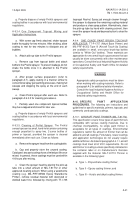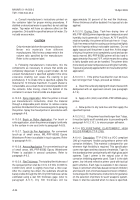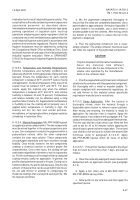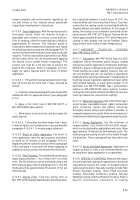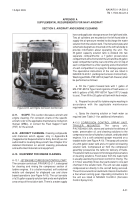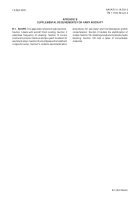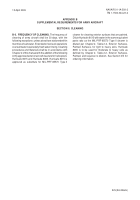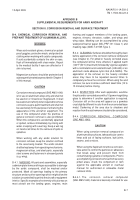TM-1-1500-344-23-2 - Page 200 of 240
A-30
NAVAIR 01-1A-509-2
TM 1-1500-344-23-2
15 April 2009
requirements applicable to individual weapons systems.
Some of the more common specialty coatings are
described below.
A-10.8.1. Rain Erosion Resistant Coatings
(AMS-C-83231 and MIL-PRF-85322). Antistatic rain
erosion resistant coatings are two component, room
temperature curing polyurethane elastomer coatings.
They are designed to protect fiber-reinforced plastic
surfaces (e.g. radomes, antennas, and leading edges)
from rain impact at high speed while preventing static
charge buildup. Many of these materials consist of
polyurethane resins and, therefore, may pose health
risks due to isocyanates. As stated in paragraph A-10.5.2,
free isocyanate vapors, even in very small
concentrations, can produce significant irritation of the
skin, eyes, and respiratory tract and may also induce
allergic sensitization of personnel. Personnel using
these materials shall consult OPNAVINST 5100.23 for
specific details. Refer to specific maintenance
instructions for information concerning the selection
and use of rain erosion resistant coatings. Consult
manufacturer’s data supplied with the material for safety,
mixing, and application instructions.
A-10.8.2. Anti-Chafe Coatings. Anti-chafe polyurethane
topcoats are primarily used on surfaces where low
friction and abrasion, impact, and chemical resistance
are required to reduce chafing and wear. Examples of
these areas are slats, flap tracks, interference areas,
and exit door areas. They are generally proprietary
materials that often contain additives such as
polytetrafluoroethylene (PTFE or Teflon). These coatings
are available in several colors, including common gray
colors used with tactical paint schemes. They are usually
supplied as two component kits that must be mixed
together in the proper proportions prior to use. Also,
anti-chafe topcoats are designed to be applied over a
primer to provide maximum performance. Refer to
specific maintenance instructions for information
concerning the selection and use of anti-chafe coatings.
Consult manufacturer’s data supplied with the material
for safety, mixing, and application instructions.
A-10.8.3. Black Conductive Coating (P/N: 8-B-6). This
material is used as a protective coating on
fiber-reinforced plastic parts, such as radomes and
helicopter rotor blades, to provide erosion protection
and dissipate static electricity. Refer to specific
maintenance instructions for information concerning
the selection and use of black conductive coatings.
Consult manufacturer’s data supplied with the material
for safety, mixing, and application instructions.
A-10.8.4. Non-Slip Walkway Coating (A-A-59166).
Walkway coatings contain grit (e.g. pumice, aluminum
oxide) to provide a nonskid surface for improved footing
on specific aircraft surfaces. Examples of these areas
are leading edge extensions (LEX) and upper walkway
surfaces. This polyurethane topcoat is supplied as a
single component material and is available in two types:
Type I has a smooth texture; Type II has a rough, gritty
texture. Both types are usually applied by brush or roller
and are available in a variety of colors, including many
of the common gray colors used with tactical paint
schemes. Refer to specific maintenance instruction
manuals for information concerning the selection and
use of non-slip walkway coatings. Consult
manufacturer's data supplied with the material for safety,
mixing, and application instructions.
A-10.8.5. Heat Resistant Coating (TT-P-28 Type I).
This is a VOC compliant (250 g/l maximum) aluminum
pigmented coating resistant to temperatures up to
1200
°
F. It is generally used on steel surfaces exposed
to temperatures in excess of the tolerance of standard
paint systems. It is supplied as a single component and
can be applied by brush or spray. After application,
allow the coating to air dry for 30 minutes followed by
baking at 400
°
F (204
°
C) for one hour. If baking is not
possible after air drying, the coating may be cured
during component use at elevated temperature. Refer
to specific maintenance instructions for information
concerning the use of heat resistant coating. Consult
manufacturer's data supplied with the material for safety
and application instructions.
A-10.8.6. Decals. Traditional painted stencils tend to
wear off due to weather and flight wear. The use of vinyl
decals instead of painted stencils has several
advantages: elimination of hazardous air pollutants
(HAPS) and hazardous waste, less frequent application,
and reduced labor requirements. Decals should not be
used in areas regularly exposed to temperatures above
150
°
F. Comply with MIL-STD-2161 requirements for
color and location of decals. Consult manufacturer's
data supplied with the material for safety and application
instructions.
Back to Top


